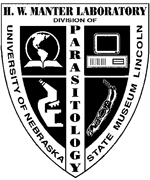Parasitology, Harold W. Manter Laboratory of

Harold W. Manter Laboratory of Parasitology: Library Materials
Document Type
Article
Date of this Version
2020
Citation
BMC Genomics (2020) 21: 862
doi: 10.1186/s12864-020-07255-w
Abstract
Background
Over the last decade, the rapid development of high-throughput sequencing platforms has accelerated species description and assisted morphological classification through DNA barcoding. However, the current highthroughput DNA barcoding methods cannot obtain full-length barcode sequences due to read length limitations (for example, a maximum read length of 300 bp for the Illumina’s MiSeq system), or are hindered by a relatively high cost or low sequencing output (e.g. a maximum number of eight million reads per cell for the PacBio’s SEQUEL II system).
Results
Pooled cytochrome c oxidase subunit I (COI) barcodes from individual specimens were sequenced on the MGISEQ-2000 platform using the single-end 400 bp (SE400) module. We present a bioinformatic pipeline, HIFI-SE, that takes reads generated from the 5′ and 3′ ends of the COI barcode region and assembles them into full-length barcodes. HIFI-SE is written in Python and includes four function modules of filter, assign, assembly, and taxonomy. We applied the HIFI-SE to a set of 845 samples (30 marine invertebrates, 815 insects) and delivered a total of 747 fully assembled COI barcodes as well as 70 Wolbachia and fungi symbionts. Compared to their corresponding Sanger sequences (72 sequences available), nearly all samples (71/72) were correctly and accurately assembled, including 46 samples that had a similarity score of 100% and 25 of ca. 99%.
Conclusions
The HIFI-SE pipeline represents an efficient way to produce standard full-length barcodes, while the reasonable cost and high sensitivity of our method can contribute considerably more DNA barcodes under the same budget. Our method thereby advances DNA-based species identification from diverse ecosystems and increases the number of relevant applications.
Included in
Biodiversity Commons, Bioinformatics Commons, Parasitology Commons, Research Methods in Life Sciences Commons


Comments
Open access material
License: CC BY 4.0 International